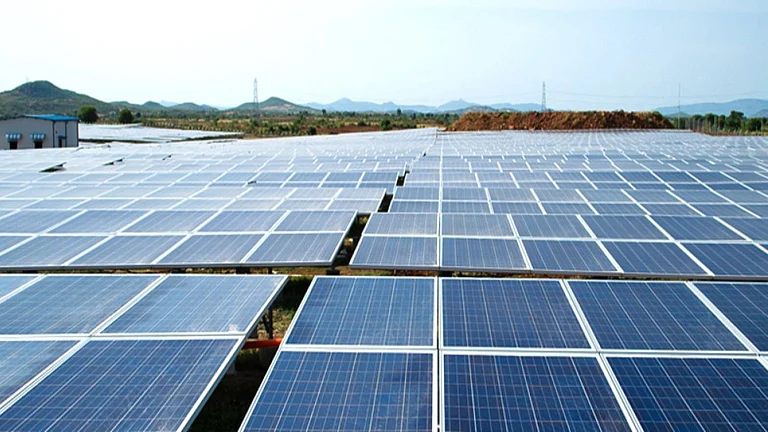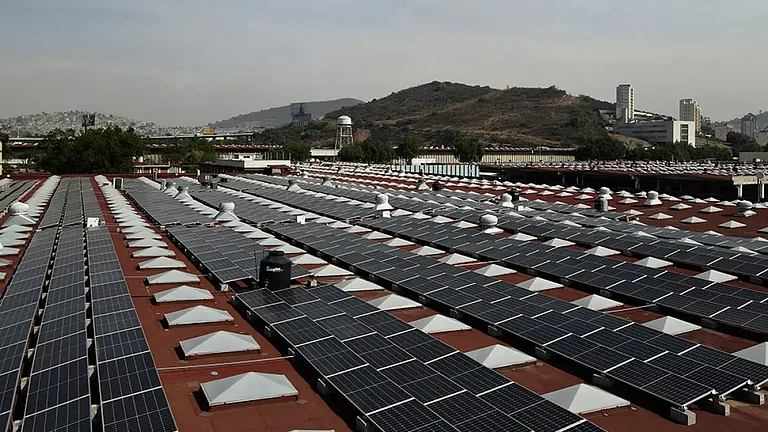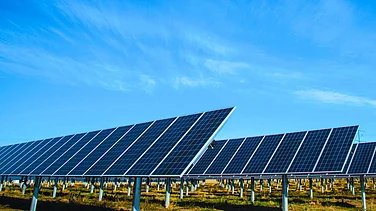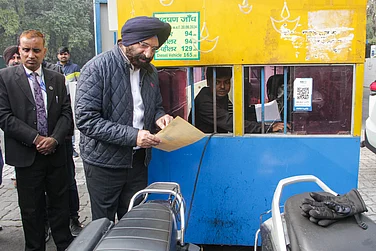The stats reveal the important: In a single year, India installed a million rooftop solar units, unevenly across the country. Equally, they conceal the vital: the “progress” fell hopelessly short of the “promise.”
Under the PM Surya Ghar Muft Bijli Yojana (PMSGY), launched by Prime Minister Narendra Modi on Feb 13, 2024, the government pledged to power one crore Indian homes with rooftop solar by 2027. In the first year it has achieved one-tenth of that number. Meaning, it now faces the very realistic target of achieving 90 lakh installations in two years!
In terms of gigawatts, the stats are just as embarrassingly revealing with the country adding a mere 3 GWs to its rooftop capacity in the year 2024-25, leaving 27 GWs to be achieved by 2027.
Trussed up in red tape and dogged by regional disparities, India’s much hyped rooftop revolution is clearly slipping on the ground as it runs up against a host of hard realities.
For a sense of how sunny the picture indeed is, check out these real-life stories.
In the town of Khandwa, 135 kilometres from Indore, Madhya Pradesh, 38-year-old schoolteacher Anjali Tiwari returned home triumphantly one sunny morning after signing up for a 3-kW rooftop system in early last year under the state’s solar subsidy scheme. She had paid the vendor Rs 45,000 upfront — her share of the subsidised cost.
More than a year later, all she has to show for her initiative and investment is a dusty metal frame on the terrace. On her mobile phone there is a long log of unanswered calls. “I was told I’d start saving on electricity within a month. It's been over a year — no panels, no power, and no refund,” she says.
Anjali’s story is by no means unique.
Local DISCOM officials admit that such cases are becoming common. “We have limited control over empanelled vendors once the initial verification is done,” says a senior MPEB official, requesting anonymity.
Far away from Khandwa, in Patna, Bihar, rooftop solar installations on government buildings are bogged down in a bureaucratic quagmire. Of the 500 targeted public buildings identified in 2022, barely 80 have operational systems. A state renewable energy department official cites tendering delays and lack of coordination with DISCOMs. “We floated tenders three times, but response from vendors was poor due to erratic payments and delays in approval.”
The story is just as grim in the dusty little town of Loharu, near Pilani, Rajasthan, home to the famous Birla Institute of Science (BITS), where individual initiatives to turn the tide of inertia have ended invariably in frustration. Says Rajesh Singh, a retired railway employee, who spent nearly six months chasing approvals for a 5 kW system in his home. “The DISCOM office kept asking for one more form or one more signature. It was worse than applying for a passport,” he laughs mirthlessly.
And so, let us return to our question: How realistic is it for the government to achieve 90 lakh rooftop installations over the next two years when all it has done over the last one year is 10 lakhs, at least some of which may not be more than metal frames.
There is more evidence to show that unless the government gets real, its dream of one crore rooftop solar by 2027, will remain just that—a dream. Of the 47.3 lakh people who applied for a rooftop system in 2024-25 only 10.09 lakh succeeded in getting one.
The fact on ground is clear: at the current pace of progress and conversion the country will log only 27 lakh installations by the deadline. Even this will not be a cakewalk as the country would have to add 10 GW of solar rooftop capacity every year till 2027.
On the face of it, the staggering under achievement appears inexplicable as, by broad expert consensus, there is no shortage of policy support. Then just who (or, what) is responsible for the fitful progress of the country’s rooftop journey?
Bottlenecks and Reasons for Missed Targets
Shortage of DCR (Domestic Content Requirement)-compliant solar modules headlines a list of impediments slowing the rooftop rollout. The crunch persists despite concerted government efforts to boost domestic manufacturing of solar panels, including a mandate requiring solar companies to use only indigenously made modules and cells. Reason? Limited manufacturing capacity and supply chain constraints, which hamstring project execution. At the same time, the sharp rise in demand exacerbates the supply gap, causing timelines to slip.
This situation calls for structural changes. Vibhuti Garg, Director, South Asia at IEEFA, emphasises, “We need to build capacities across the value chain—especially upstream in areas like polysilicon, wafers, and ingots, where we still depend on imports. Cell manufacturing has improved, but more needs to be done across the board.”
Along with their strained availability, many PMSGY vendors cite the significant price difference between DCR and imported modules as a major constraint, because of its obvious impact on competitiveness.
Echoing this, Charith Konda, Energy Specialist at India Mobility and New Energy, notes, “India is in the process of developing a domestic solar manufacturing ecosystem, but it’s still in the early stages. Some Indian-made panels are finding markets in the U.S. and Europe, where price differences are less of a hurdle. However, within India, the higher cost remains a significant barrier to widespread adoption.”
The government has responded to the growing disquiet with well-meaning assurances—but that simply does not cut it. There is still no clarity on when or how — if at all — the promised 18 GW of domestic manufacturing capacity will be achieved. What’s known is that India’s current capacity languishes at just 8.1 GW.
“Whenever we enter a new manufacturing sector, price gaps are inevitable — that’s precisely why government support is critical. DCR modules cost more today simply because the industry hasn’t yet matured in technology or scale. Competing with Chinese modules will remain tough until that happens”, said a senior government official.
Regional Disparities and Lack of Coordination with States
Despite the headwinds, however, the PMSGY scheme is growing—the trouble is that the growth is lop-sided, with frontrunners like Gujarat and Maharashtra, which together account for 64.26% of all rooftops solar installations, on a tear, while the others trail far behind. For example, the next three–Uttar Pradesh (8.69%), Kerala (7.73%) and Rajasthan (3.14%) --contribute only 19.56%. The rest of the states, combined, make up barely one-sixth of the total installations. The result? A patchy rollout that undermines the idea of national transition and makes grid planning, subsidy disbursal and supply chains harder to manage by creating solar haves and have-nots.
Analysts attribute such disparate development primarily to electricity tariffs. “Urban areas with higher tariffs see more uptake, as the shift to solar offers significant savings. In contrast, in rural regions or states with low electricity tariffs, the financial incentive is weak,” says Anujesh Dwivedi, Partner, Deloitte India.
Further, Garg at IEEFA highlights the critical role of states, noting, “Electricity is a concurrent subject, so states have a major role. States with favourable net metering policies are seeing faster deployment. The central government is doing its part, but if states don’t implement policies effectively, it becomes a state-level issue rather than a central one.”
Moreover, the policy of several state governments to provide free electricity to consumers discourages solar adoption. Worse, since these governments must raise funds elsewhere to pay for the politically expedient dole, they often discourage business consumers who run up large bills from switching to solar. This contradiction stifles the growth of solar rooftop and undermines the broader goal of sustainable development.
Subsidy Disbursal Issues and Delayed Approvals
A key draw of the scheme is its subsidy—up to Rs 78,000 for rooftop solar systems of up to 3KW. The government promises to credit the amount within 15 days. But the reality, unfortunately, bites—again. Of the 10.09 lakh installations so far, only 6.13 lakh households have received the subsidy. That leaves over 4 lakhs still waiting, exposing a gaping hole between policy promise and delivery. Given that word-of-mouth is often the most powerful way of promoting such socially relevant initiatives—and the fact that negative news travels fast—such defaults are hardly the best way of popularising rooftop solar.
According to an IEEFA study on residential rooftop solar potential, delayed subsidies are a major dampener, disrupting cash flows, straining consumer-vendor relationship and eroding stakeholder confidence in the programme. Given that this should not be hard to guess, even without a study, why do the delays happen?
Subsidy flow is interrupted at two stages, with DISCOMs dragging their feet over approving the technical feasibility of installations after applications have been submitted and, later, at the stage of inspection post-commissioning. Many a time, the ordeal drags on with the DISCOMS not okaying the commissioning status even after successful inspection and net meter installation. Subsidy disbursal is the direct casualty of such lethargy. There is not a single case of any DISCOM being called out, let alone being penalised for such conduct.
The NPRS portal too proves to be a source of frustration, with consumers and vendors alike from several states citing technical glitches, starting with faulty OTP authentication for login. Applying for new systems on the system is a challenge in itself, which is compounded by the inconsistency of information provided by the NRPS and the Jan Samarth portals on financing options. It is not easy to track the project status either.
To encourage rooftop adoption, the government introduced collateral-free loans of up to Rs 2 lakhs at a subsidised interest rate of 6.75% through 12 Public Sector Banks. Yet, despite its apparent appeal, the response to the offer has been disappointingly tepid—only 3.1 lakh out of 47.3 lakh eligible individuals have applied, reflecting a participation rate of just 6.5%. The story does not get better with the banks approving loans to only 1.58 lakhs of the small number of applicants—an unconscionable rejection rate of nearly 50%. Since Income Tax Returns (ITRs) papers are not required for the sanction of these loans, one wonders what accounts for such a high rejection rate?
Path Forward
The PMSGY has immense potential, but its execution demands rapid, focused action. To meet the target of one crore installations by 2027, immediate attention is needed to address issues like DCR module availability, regional disparities and timely loan and subsidy disbursal. Additionally, allowing more flexibility in Domestic Content Requirement policies will help ensure a steady, affordable supply of PV modules even as domestic manufacturing capabilities catch up. Says Garg at IEEFA, “We need to strengthen R&D in India. We still rely heavily on imported technologies, which are expensive. Indigenous R&D and product development should be a priority moving forward. I spoke with another OEM player who mentioned that demand is outpacing supply, mainly because of the Domestic Content Requirement (DCR). Manufacturing needs to catch up to meet deployment demand.”
Agrees Konda at India Mobility and New Energy, “Some companies are starting to integrate up to the ingot level, but matching China is very difficult. They have scale, technology, and a mature ecosystem. We’re still building capacity and trying to innovate simultaneously. China is already innovating on top of a well-established base.”
For most Indian households, solar energy remains a distant concept. To drive adoption, both central and state governments must throw their collective weight behind creating awareness and building confidence The government could possibly create a specialised agency that acts as a buddy, hand-holding consumers through the Byzantine path of bringing a roof-top system home. Such an agency could liaison between consumers and DISCOMs and drive awareness and community outreach campaigns.
Finally, a smooth-functioning national portal is vital for scaling the rooftop solar project to its full potential. Upgrading the portal’s IT infrastructure—adding more robust data centres and high-capacity servers—will resolve many of the current issues and ensure better performance and scalability.
To realise its rooftop solar dreams India must overhaul the system across all levels and find effective ways around critical supply chain bottlenecks, inter-state disparities and subsidy disbursal chokepoints. Ultimately, nothing would drive the widespread adoption of rooftop solar more than the positive experience of existing consumers.
However, without decisive action and a clear roadmap, the promise of clean, affordable energy for millions may remain a tantalising idea rather than a tangible reality. The coming years will determine if India’s ambition of one crore solar homes has a sunny future or it fades into the dusk of unfulfilled promises.



































